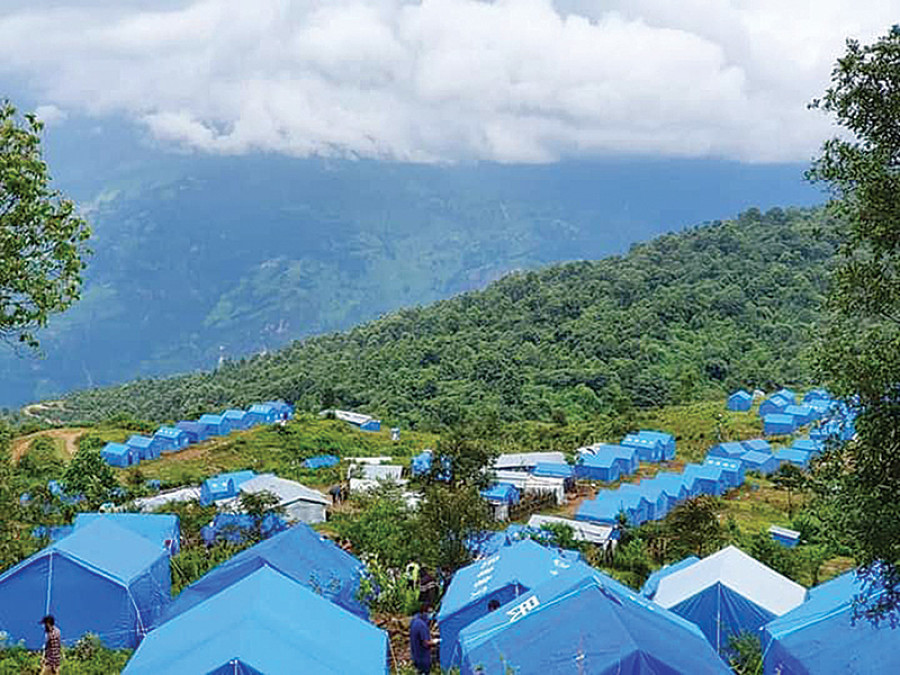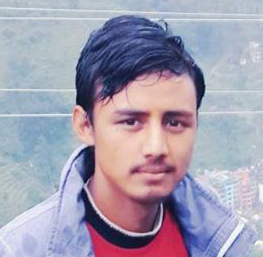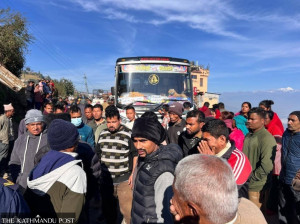Bagmati Province
While government formulates resettlement plan, landslide survivors live in leaking tents
Governance is not only providing immediate relief but also ensuring support so that survivors have the wherewithal to start new lives, experts say
Anish Tiwari & Timothy Aryal
Deep into the forest of Bashkharka, in Sindhupalchok, lie several rows of blue tents. It is where the survivors of the Lidi landslide in August this year have been relocated. Each tent has a sack of rice, some cooking pots, and tarpaulins used as carpets and shield from the cold of the moist soil.
Resham Dong, one of the inhabitants in the tent settlement, sits on the ground in front of his tent, looking over the hills. Seven of the 36 people who died in the Lidi landslide, were family members of Dong and he is reeling under the emotional toll of the disaster, but the problems at this temporary settlement are more immediate. His tent leaks when it rains.
”Since the earthquakes of 2015, we have been moving here and there,” he said. “This is the latest episode. The tents leak and the facilities are not up to the mark. This has been frustrating.”
The temporary settlement, set up by the District Coordination Committee in partnership with the Crisis Relocation Committee, local representatives and various organisations, has 98 tents in total. This was also the site of the temporary settlement for quake victims, and for many it is a return to a familiar territory.
A total of 172 households were relocated to this site after the landslides but some of the people have moved in with their relatives due to lack of space.
According to Hom Bahadur Shrestha, the Jugal Rural Municipality chair, the Bashkharka settlement is only a temporary one and his office will come up with a long-term plan on how to rehabilitate the displaced.
”We are creating a rough sketch of a model integrated settlement to rehabilitate the displaced,” Shrestha said. ”We have to discuss it with the upper echelons of the government. We have understood the pains the survivors have had to go through and we will come up with a plan respecting that.”
But the federal government is still studying the situation.
Anil Pokhrel, chief executive at National Disaster Risk Reduction and Management Authority, said that his office is currently formulating a "detailed plan" to resettle the displaced.
“We are still in the preliminary stage of responding to the disasters in Sindhupalchok. We will come up with plans on how to rehabilitate the displaced,” he said.
Meanwhile, six years on, many families displaced by the Jure landslide of 2104, which killed 156, are still living in temporary settlements.
Chari Bahadur Tamang, chair of Balefi ward 8, where Jure lies, said that his office has done everything in its capacity to help rehabilitate the Jure displaced. Of the 122 displaced in the Jure landslide, 70 are still at the temporary settlements, according to him.
”We have asked for help from the upper levels of the government but no help has come so far,” Tamang said. ”The government has left us helpless.”
As many as 3290 households are currently displaced, from multiple disasters, in the district and awaiting rehabilitation, according to data by the District Administration Office.
On Sunday, Sindhupalchok saw yet another landslide, one of the over two dozens that have occurred in the district this monsoon season. The disaster struck three settlements in Ghumthang in the wee hours while villagers were asleep. Following a night of incessant rains, the mud flow washed away 22 houses in Bhirkharka, Nagpuje and Dandagaun settlements and killed 12 people. Twenty individuals are still missing and are feared dead.
The ongoing monsoon season has been one of the deadliest the nation has seen in decades. According to official data, 270 have died in the landslides this year, 206 are injured, and 66 are still missing. Among the districts, Sindhupalchok has been hit especially hard; 70 have lost their lives, while 39 are still missing.
While disasters continue, the displaced have been compelled to stay in temporary settlements.
Janardan Gautam, spokesperson for the National Disaster Risk Reduction and Management Authority, conceded that the state has not been successful in rehabilitating the displaced from previous disasters, not just in Sindhupalchok but across the country.
Formerly the Ministry of Urban Development was tasked with risk reduction and rehabilitation of the displaced, but that task is now transferred to the authority after its formation less than a year ago, he said.
According to Ajay Dixit, the author of the 2016 book Nepal Ma Bipat, or Disasters in Nepal, and a water disasters analyst, the same story has been repeating for decades.
“Why is it that the same story of the victims of landslides, earthquakes, droughts, and floods repeats decade after decade?” he said. “The state’s function has been only to provide immediate relief but after that it thinks its job is finished. Immediate relief is needed and important. But after the immediate aftermath is over, the survivors require support and wherewithal to restart a life. And that’s where the proper governance needs to come in.”
The makeshift residences at the temporary settlements are ill-managed and have substandard facilities, inhabitants say.
Another inhabitant of the Baaskharka temporary camp, 45-year-old Sangbo Dong, who lost his wife and son in the landslide, wondered if he’d better return to Lidi and set up a hut than stay under the tent that leaks. “We want a safe habitat for us,” he said, “now and in the future. But we are uncertain about both.”
Dong and his fellow villagers had built their homes after the earthquakes of 2015 with the compensations from the government. But Dong’s new house was swept away by the Lidi landslide this year. After the landslides, Jugal Rural Municipality chief Shrestha and ward 2 chair Pratap Lama had asked the survivors to stay in temporary settlements for two months. The perception then is that there would be a new arrangement after two months.
But one month after the landslide, the inhabitants now have little hope that they will be rehabilitated anytime soon, according to Sang Bahadur Dong, another inhabitant at the Banskharka settlement. ”I worry about my children more than myself,” he said. ”And I hope that they wouldn’t have to go through what I have.”
Looking back at the history of rehabilitation of the displaced, it’s hard to say that Dong’s children won’t have to go through the same plight he has.
Nepal now has a federal system of government with empowered local units. In 2017, the Disaster Risk Management Act was passed. And last year the National Disaster Risk Reduction and Management Authority was formed.
With the establishment of a whole authority toward reducing disasters and managing them, the state should have performed better in its response to the natural hazards, says Dixit.
“The state has its procedures and a system in place,” Dixit said. “With the same story repeating year after year, the state needs to think if the institutions set up to deal with the disasters are functioning well.”
Coordinator of a committee of the displaced formed after the Lidi landslide, Resham Dong, said that they have asked the local units to provide them compensation within two months. ”We are ready to hand over the lands we lost in the landslides to the government. In return, we want equivalent land elsewhere,” Resham said.
Given Nepal’s social and environmental realities, the development paradigm may need a rethink, according to experts.
Geologists say that haphazard, unscientific construction works and prolonged rainfall on top of a fragile geography have contributed to numerous natural hazards in the district this year.
“Maybe there's a mismatch between our developmental aspirations—roads, connectivity—and the environmental, social realities—landslides, floods,” said Dixit.
“The process of risk reduction and rehabilitating the displaced remains a challenge,” Gautam, the spokesperson for National Disaster Risk Reduction and Management Authority, told the Post. “The previous government agencies haven’t met success in managing the disaster and its aftereffects. We are currently formulating plans and methodologies to tackle the problem.”
“The empathy that is desired from the state is missing. This begs the question, how do we value life in our society?” said Dixit.
Back in Sindhupalchok, Subas Tamang, 26, has been staying at the temporary settlement since the Jure landslide six years ago. ”With no resource, I can’t build a home elsewhere,” Tamang said. “Moving from here is out of the question at the moment.”




 7.12°C Kathmandu
7.12°C Kathmandu












